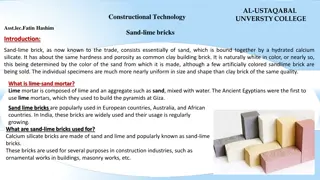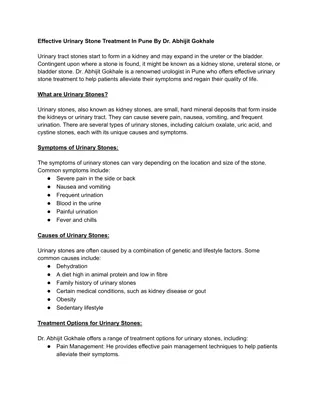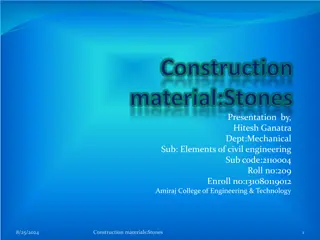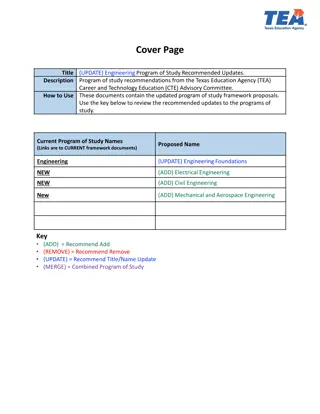Stones and Bricks in Construction Engineering
Stones and bricks are essential materials in construction engineering, providing strength and durability to structures. Stones are classified based on geological, physical, and chemical properties, while bricks come in traditional and modular types with specific compositions. The properties of a good stone include structure, texture, strength, and more. Both materials have various uses in construction, from foundations to roads and railways.
Download Presentation

Please find below an Image/Link to download the presentation.
The content on the website is provided AS IS for your information and personal use only. It may not be sold, licensed, or shared on other websites without obtaining consent from the author.If you encounter any issues during the download, it is possible that the publisher has removed the file from their server.
You are allowed to download the files provided on this website for personal or commercial use, subject to the condition that they are used lawfully. All files are the property of their respective owners.
The content on the website is provided AS IS for your information and personal use only. It may not be sold, licensed, or shared on other websites without obtaining consent from the author.
E N D
Presentation Transcript
Silver Oak College Of Engineering & Technology. Prepared By: PAREKH PRATIKKUMAR (29) JATIN DAVE (45) SHAH PEARL NEELAMKUMAR (58) Guided By: Prof. Hasumati Patel
STONE Stone: A natural engineering material mainly derived from rocks. They are available in variety of colors, form and structures. Stones are strong, durable and descent in appearance.
Classification on Stones Mainly classified in 3 ways.. 1) Geological Classification Igneous Rocks Sedimentary Rocks Metamorphic Rocks 2) Physical Classification Stratified Rocks Unstratified Rocks Foliated Rocks
3) Chemical Classification Siliceous Rocks Argillaceous Rocks Calcareous Rocks
Uses of stone STONES ARE USED FOR, Foundations, columns, walls, lintels, arches, floors, damp proof courses, sills etc.. Heavy engg. Works i.e. Dams, Docks, Bridges, Piers, retaining walls, abutments, lighthouses etc.. Paving of roads, footpaths etc.. Railways tracks as ballast.
Required Properties of Good Stone 1) Structure 2) Texture 3) Strength 4) Hardness 5) Durability 6) Water Absorption 7) Specific Gravity 8) Resistance to fire 9) Facility of dressing 10) Appearance and color
BUILDING MATERIAL: BRICKS
BRICKS Composition: Material Amount of composition Alumina 20-30 % Silica 50-60% Lime 4-6% Iron Oxides 4-6% Magnesium A small Quantity
Types of Bricks Traditional Bricks: Size:: 23 cm * 11.4 cm * 7.6 cm Modular Bricks: Size :: 19 cm * 9 cm * 9 cm
Classification of Bricks First Class Bricks : Used for Superior work of permanent nature Second Class Bricks : Used for making ballast Third Class Bricks : Used for inferior and unimportant works Fourth Class Bricks : Used as aggregate for concrete in foundations, floors, roads etc..
Qualities of Good Brick Bricks should have, Regular size and shape, Uniform and brick-red color, Low thermal conductivity, Good strength, Enough hardness, Sound proof, Metallic ringing sound when two bricks are struck together..
BUILDING MATERIAL : LIME
LIME Important cementing material used in engineering construction. It is the material which has the capacity of holding structural units (like bricks, stones, aggregate) together with sufficient strength. Classification of lime is, Fat Lime, Hydraulic lime, Poor lime.
Properties of lime Fat Lime, Hardens very slowly, Slakes vigorously, Has a high degree of plasticity, Has perfectly white color. Hardens in combination with air,
Hydraulic lime, Hardens in combination with water, Contains 5-30 % of water, Does not shrink much, Is not perfectly white colored, Forms a thin paste with water, Slakes very slowly. Poor lime, Contains more than 30% of clay, Slakes and sets very slowly.
USES OF LIME Whitewashing and plastering of walls, Preparation of mortar for thick walls, damp places etc., Construction under water, First class brick and stone masonry works, For inferior works, Production of good mortar.
BUILDING MATERIAL : BITUMEN
BITUMEN The Bitumen is a binding material which is present in asphalt. It is black in color and obtained in solid/semi solid state. Bituminous materials are very commonly used in highway construction and pavements.
Classification of Bitumen Asphalt, Tar, Cut-back, Emulsion.
Functions of Bituminous Materials Binding Effect, Cushion, Sealing of surface, Resistance to weathering agents.






















